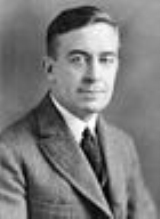
Alfred V. Verville
Encyclopedia
Alfred Victor Verville was an aviation pioneer and designer who contributed to civilian and military aviation. During his 47 years in the aviation industry, he led the design and development of nearly a dozen commercial and military airplanes. He is known for his design of flying boats, a cantilever monoplane with retractable landing gear: the Verville-Sperry R-3, military racing
airplanes, and a series of commercial cabin airplanes. His wife was Bertha M. Kamrath, married 1917, with whom he had two daughters, Betty and Janet and a son Bud. Verville worked for General William "Billy" Mitchell while working at the United States Army Air Service
.
he helped design the Curtiss Jenny
and Curtiss twin engine seaplane. Verville also worked for Curtiss Aeroplane and Motor Company
, Thomas-Morse Airplane Company
, General Aeroplane Company (1915–1917), and Fisher Body Corporation
(as executive engineer, 1917-1918) before joining the Engineering Division
of the U.S. Army Air Service as a civilian in 1918. In 1925, he left government service to co-found the Buhl-Verville Aircraft Company
. In 1928, he left Buhl-Verville to establish Verville Aircraft Company, which failed in 1931 in part due to the difficult economic environment
of the times.
(1937-38), at Curtiss-Wright
(1941-42), at Snead Aircraft (1942), and at Drexel Aviation Co (1942-45). In 1945 he served as a member of the Naval Technical Mission to Europe and later joined the US Navy's Bureau of Aeronautics
(1946-61). His retirement was in 1961, but he continued to support the field of aviation until his death in 1970.
, which is a competitive nine- to twelve-month in-residence fellowship for researching the history of aviation. Verville has over 20 boxes of material at the Smithsonian Air and Space Museum - Garber Facility
from his estate.
In Verville's honor, a 33 cent United States Postal Service
airmail stamp was issued on February 13, 1985 bearing his name, picture, the text "Aviation Pioneer", and an image of his Verville-Packard R-1
low-wing monoplane.
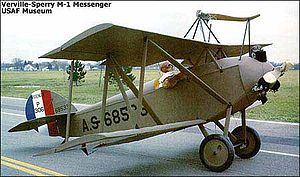

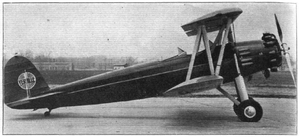
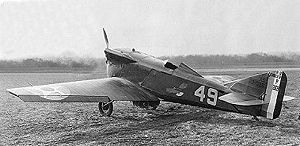
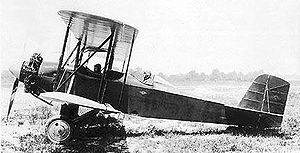
Gamma S
Gamma L
Verville-Clark-Pursuit 1 & 2
(aka VCP-1 & VCP-2)
Verville R-1 Racer
(1920) (aka Verville-Packard R-1 or VCP-R)
Verville-Sperry R-3 Racer
(1922)
YPT-10 (1925-48), Primary Trainer
(1929)
, which is a competitive nine- to twelve-month in-residence fellowship for researching the history of aviation. The fellowship includes a $50,000 stipend with limited additional funds for travel and miscellaneous expenses.
Candidates for the fellowship should pursue programs of research and writing that support publication of works that are scholarly in tone and substance. These materials should appeal to an audience with broad interests. Outstanding manuscripts resulting from this program may be offered to the Smithsonian Institution
Press for publication.
Verville Racer Aircraft
-R-1 Racer:The Verville-Packard R-1 Racer was a military racing aircraft that was based on Alfred Verville's previous VCP-1 design. The R-1 is sometimes known also as the VCP-R or the Verville-Packard 600. The R-1 was the first racing aircraft built for the United States Army Air Corps...
airplanes, and a series of commercial cabin airplanes. His wife was Bertha M. Kamrath, married 1917, with whom he had two daughters, Betty and Janet and a son Bud. Verville worked for General William "Billy" Mitchell while working at the United States Army Air Service
United States Army Air Service
The Air Service, United States Army was a forerunner of the United States Air Force during and after World War I. It was established as an independent but temporary wartime branch of the War Department by two executive orders of President Woodrow Wilson: on May 24, 1918, replacing the Aviation...
.
Early career
Early in life, Verville took a correspondence course in Electrical Engineering. His aviation career began in 1914, at the age of 24, after leaving the Hudson Motor Company. With Glenn CurtissGlenn Curtiss
Glenn Hammond Curtiss was an American aviation pioneer and a founder of the U.S. aircraft industry. He began his career as a bicycle then motorcycle builder and racer, later also manufacturing engines for airships as early as 1906...
he helped design the Curtiss Jenny
Curtiss JN-4
The Curtiss JN-4 "Jenny" was one of a series of "JN" biplanes built by the Curtiss Aeroplane Company of Hammondsport, New York, later the Curtiss Aeroplane and Motor Company. Although the Curtiss JN series was originally produced as a training aircraft for the U.S...
and Curtiss twin engine seaplane. Verville also worked for Curtiss Aeroplane and Motor Company
Curtiss Aeroplane and Motor Company
Curtiss Aeroplane and Motor Company was an American aircraft manufacturer that went public in 1916 with Glenn Hammond Curtiss as president. Throughout the 1920s and 1930s, the company was the largest aircraft manufacturer in the United States...
, Thomas-Morse Airplane Company
Thomas-Morse Aircraft
The Thomas-Morse Aircraft Corporation was an American aircraft manufacturer, until it was taken over by the Consolidated Aircraft Corporation in 1929.Founded by English expatriates William T. and his brother Oliver W...
, General Aeroplane Company (1915–1917), and Fisher Body Corporation
Fisher Body
Fisher Body is an automobile coachbuilder founded by the Fisher brothers in 1908 in Detroit, Michigan; it is now an operating division of General Motors Company...
(as executive engineer, 1917-1918) before joining the Engineering Division
Engineering Division
The Engineering Division was a division of the Aviation Section, U.S. Signal Corps in the United States Department of War. It was formed on 31 August 1918, under the direction of Lt Col Jesse G. Vincent, to study and design American versions of foreign aircraft. It was later renamed Engineering...
of the U.S. Army Air Service as a civilian in 1918. In 1925, he left government service to co-found the Buhl-Verville Aircraft Company
Buhl Aircraft Company
The Buhl Aircraft Company was founded in 1925 by the Buhl family of Detroit. The family owned the Buhl Stamping Company and the Buhl Building. Buhl manufactured the first aircraft to receive an Approved Type Certificate. Certificate #1 was awarded to Buhl for the Buhl-Verville CA-3 Airster in March...
. In 1928, he left Buhl-Verville to establish Verville Aircraft Company, which failed in 1931 in part due to the difficult economic environment
Great Depression in the United States
The Great Depression began with the Wall Street Crash of October, 1929 and rapidly spread worldwide. The market crash marked the beginning of a decade of high unemployment, poverty, low profits, deflation, plunging farm incomes, and lost opportunities for economic growth and personal advancement...
of the times.
Consulting and retirement
For the next two decades, he served as a consultant at the Bureau of Air Commerce (1932, 1939-41) and Department of Commerce (1933-36), at Douglas AircraftDouglas Aircraft Company
The Douglas Aircraft Company was an American aerospace manufacturer, based in Long Beach, California. It was founded in 1921 by Donald Wills Douglas, Sr. and later merged with McDonnell Aircraft in 1967 to form McDonnell Douglas...
(1937-38), at Curtiss-Wright
Curtiss-Wright
The Curtiss-Wright Corporation was the largest aircraft manufacturer in the United States at the end of World War II, but has evolved to largely become a component manufacturer, specializing in actuators, aircraft controls, valves, and metalworking....
(1941-42), at Snead Aircraft (1942), and at Drexel Aviation Co (1942-45). In 1945 he served as a member of the Naval Technical Mission to Europe and later joined the US Navy's Bureau of Aeronautics
Bureau of Aeronautics
The Bureau of Aeronautics was the U.S. Navy's material-support organization for Naval Aviation from 1921 to 1959. The bureau had "cognizance" for the design, procurement, and support of Naval aircraft and related systems...
(1946-61). His retirement was in 1961, but he continued to support the field of aviation until his death in 1970.
Honors
Verville was selected as a fellow of the Smithsonian's National Air Museum in 1962. He was honored with ten Certificates or Letters of Commendations from the U.S. Armed Forces. He was an Honorary Fellow of the Society of Experimental Test Pilots, and was named an Elder Statesman of Aviation in 1956. He held eight aeronautical patents. A fellowship was established in his name at the Smithsonian National Air and Space MuseumNational Air and Space Museum
The National Air and Space Museum of the Smithsonian Institution holds the largest collection of historic aircraft and spacecraft in the world. It was established in 1976. Located in Washington, D.C., United States, it is a center for research into the history and science of aviation and...
, which is a competitive nine- to twelve-month in-residence fellowship for researching the history of aviation. Verville has over 20 boxes of material at the Smithsonian Air and Space Museum - Garber Facility
Paul E. Garber Preservation, Restoration, and Storage Facility
The Paul E. Garber Preservation, Restoration, and Storage Facility is located in Suitland, Maryland, USA. The facility, also nicknamed "Silver Hill", is where the Smithsonian Institution's National Air and Space Museum restores aircraft, spacecraft, and other artifacts.It is named in honor of...
from his estate.
In Verville's honor, a 33 cent United States Postal Service
United States Postal Service
The United States Postal Service is an independent agency of the United States government responsible for providing postal service in the United States...
airmail stamp was issued on February 13, 1985 bearing his name, picture, the text "Aviation Pioneer", and an image of his Verville-Packard R-1
Verville Racer Aircraft
-R-1 Racer:The Verville-Packard R-1 Racer was a military racing aircraft that was based on Alfred Verville's previous VCP-1 design. The R-1 is sometimes known also as the VCP-R or the Verville-Packard 600. The R-1 was the first racing aircraft built for the United States Army Air Corps...
low-wing monoplane.
Planes designed by Verville





Most famous
- Verville Sperry M-1 MessengerSperry Messenger|-See also:-External links:*...
- this plane is on display in the National Air and Space Museum Steven F. Udvar-Hazy CenterSteven F. Udvar-Hazy CenterThe Steven F. Udvar-Hazy Center is the Smithsonian National Air and Space Museum 's annex at Washington Dulles International Airport in the Chantilly area of Fairfax County, Virginia, United States.... - Verville Sport Trainer - this plane is in storagePaul E. Garber Preservation, Restoration, and Storage FacilityThe Paul E. Garber Preservation, Restoration, and Storage Facility is located in Suitland, Maryland, USA. The facility, also nicknamed "Silver Hill", is where the Smithsonian Institution's National Air and Space Museum restores aircraft, spacecraft, and other artifacts.It is named in honor of...
in the Smithsonian Institution system, its engine was a Packard DR-980
General Aeroplane Company
Verville Flying Boat (1916)- 2 passenger, open cockpit, biplane flying boatFlying boatA flying boat is a fixed-winged seaplane with a hull, allowing it to land on water. It differs from a float plane as it uses a purpose-designed fuselage which can float, granting the aircraft buoyancy. Flying boats may be stabilized by under-wing floats or by wing-like projections from the fuselage...
- 100 hp Curtiss OX-5 or Maximotor pusher
- Mahogany hull and wing floats constructed by Mayea Boat Co (Detroit)
Gamma S
- a two seater, open cockpit, floatplaneFloatplaneA floatplane is a type of seaplane, with slender pontoons mounted under the fuselage; only the floats of a floatplane normally come into contact with water, with the fuselage remaining above water...
, biplane with a 80 hp Le RhôneLe RhôneLe Rhône was the name given to a series of popular rotary aircraft engines produced in France by Société des Moteurs Le Rhône and the successor company of Gnome et Rhône. They powered a number of military aircraft types of the First World War...
pusher engine
Gamma L
- similar to Gamma S, but with wheels
- Twin floats were replaced with wheels for winter operations off the ice of Lake St Clair
U.S. Military
- Main articles: Verville VCP FighterVerville VCP Fighter|-References:*Angelucci, Enzo and Peter M. Bowers. The American Fighter. Sparkford, UK:Haynes Publishing Group, 1987. ISBN 0-85429-635-2.*Boyne, Walter J. "The Treasures of McCook Field: America's First Aero Engineering and Testing Centre, Part 1". The Best of Wings Magazine. Washington...
& Verville Racer AircraftVerville Racer Aircraft-R-1 Racer:The Verville-Packard R-1 Racer was a military racing aircraft that was based on Alfred Verville's previous VCP-1 design. The R-1 is sometimes known also as the VCP-R or the Verville-Packard 600. The R-1 was the first racing aircraft built for the United States Army Air Corps...
Verville-Clark-Pursuit 1 & 2
Verville VCP Fighter
|-References:*Angelucci, Enzo and Peter M. Bowers. The American Fighter. Sparkford, UK:Haynes Publishing Group, 1987. ISBN 0-85429-635-2.*Boyne, Walter J. "The Treasures of McCook Field: America's First Aero Engineering and Testing Centre, Part 1". The Best of Wings Magazine. Washington...
(aka VCP-1 & VCP-2)
- Function: fighter
- two VCP-1 and two VCP-2 built
- VCP-1 redesignated VCP-1A & R-1 Racer, VCP-2 redesignated PW-1 & PW-1A
- while at Engineering DivisionEngineering DivisionThe Engineering Division was a division of the Aviation Section, U.S. Signal Corps in the United States Department of War. It was formed on 31 August 1918, under the direction of Lt Col Jesse G. Vincent, to study and design American versions of foreign aircraft. It was later renamed Engineering...
& Aeronautical Systems CenterAeronautical Systems CenterThe Aeronautical Systems Center is an Air Force product center that designs, develops and delivers dominant aerospace weapon systems and capabilities for U.S. Air Force, other U.S. military, allied and coalition-partner warfighters, in support of Air Force leadership priorities...
of Signal Corps - Post-War, November 11, 1918 to September 1919
Verville R-1 Racer
Verville Racer Aircraft
-R-1 Racer:The Verville-Packard R-1 Racer was a military racing aircraft that was based on Alfred Verville's previous VCP-1 design. The R-1 is sometimes known also as the VCP-R or the Verville-Packard 600. The R-1 was the first racing aircraft built for the United States Army Air Corps...
(1920) (aka Verville-Packard R-1 or VCP-R)
- Function: racing, crew: 1, engines: 1x 638 hp Packard 1A-2025 V-12
- On November 27, 1920, Capt. Corliss Moseley, flying a Verville-Packard VCP-R racer won the Pulitzer Trophy Race at Mitchel Air Force BaseMitchel Air Force BaseDecommissioned in 1961, Mitchel Field became a multi-use complex currently home to the Cradle of Aviation Museum, Nassau Coliseum, Mitchel Athletic Complex, Nassau Community College and Hofstra University.-Origins:...
with maximum speed 177 mph - while in Air ServiceUnited States Army Air ServiceThe Air Service, United States Army was a forerunner of the United States Air Force during and after World War I. It was established as an independent but temporary wartime branch of the War Department by two executive orders of President Woodrow Wilson: on May 24, 1918, replacing the Aviation...
Verville-Sperry R-3 Racer
Verville Racer Aircraft
-R-1 Racer:The Verville-Packard R-1 Racer was a military racing aircraft that was based on Alfred Verville's previous VCP-1 design. The R-1 is sometimes known also as the VCP-R or the Verville-Packard 600. The R-1 was the first racing aircraft built for the United States Army Air Corps...
(1922)
- participated in the 1922,23,&24 Pulitzer Trophy RacesNational Air RacesThe National Air Races were a series of pylon and cross-country races that took place in the United States from 1920 to 1949. The science of aviation, and the speed and reliability of aircraft and engines grew rapidly during this period; the National Air Races were both a proving ground and...
, won first place in 1924
YPT-10 (1925-48), Primary Trainer
- Similar design to Verville Sport Trainer ATVerville Sport Trainer ATThe Verville Sport Trainer AT was a two-seat tandem biplane designed by Alfred V. Verville as a civilian version of the YPT-10 primary trainer, intended to appeal to the wealthy private owner....
- while at Air CorpsUnited States Army Air CorpsThe United States Army Air Corps was a forerunner of the United States Air Force. Renamed from the Air Service on 2 July 1926, it was part of the United States Army and the predecessor of the United States Army Air Forces , established in 1941...
Buhl-Verville
Buhl-Verville CA-3/CW-3 Airster (also known as the J4/J5 Airster or B-V Airster)- CA-3 Airster, 200 hp Wright J-4 engine
- CA-3A Airster, 225 hp Wright J-5 engine
- CA-3B Airster
- CW-3 OX5 Airster, 90 hp Curtiss OX-5 engine
- CW-3 Wright Trainer, 220 hp Wright J-5 engine (short military trial)
Verville Aircraft Company
Verville Air CoachVerville Air Coach
The Verville Air Coach was a four passenger, high-wing monoplane designed in 1929 by Alfred V. Verville and produced by his company, Verville Aircraft Company. It was a comfortable, good-looking cabin monoplane which sold for $10,500...
(1929)
- Model 102 (104-W, Warner Engine)
- Model 104-C
- Model 104-P (Packard Diesel Coach)
Verville Smithsonian Fellowship
A fellowship was established in his name at the Smithsonian National Air and Space MuseumNational Air and Space Museum
The National Air and Space Museum of the Smithsonian Institution holds the largest collection of historic aircraft and spacecraft in the world. It was established in 1976. Located in Washington, D.C., United States, it is a center for research into the history and science of aviation and...
, which is a competitive nine- to twelve-month in-residence fellowship for researching the history of aviation. The fellowship includes a $50,000 stipend with limited additional funds for travel and miscellaneous expenses.
Candidates for the fellowship should pursue programs of research and writing that support publication of works that are scholarly in tone and substance. These materials should appeal to an audience with broad interests. Outstanding manuscripts resulting from this program may be offered to the Smithsonian Institution
Smithsonian Institution
The Smithsonian Institution is an educational and research institute and associated museum complex, administered and funded by the government of the United States and by funds from its endowment, contributions, and profits from its retail operations, concessions, licensing activities, and magazines...
Press for publication.
Fellowship selections
- 2007-2008 - Dr. Richard HallionRichard P. HallionDr. Richard P. Hallion is Senior Adviser for Air and Space Issues, Directorate for Security, Counterintelligence and Special Programs Oversight, the Pentagon, Washington, D.C. He is responsible for analysis and insight regarding the conceptualization, evolution and utilization of sensitive national...
, Topic: role of NACA Technical Representative John Jay Ide in air intelligence and the transfer of technical information between Europe and America - 2006-2007 - Dr. Christine Yano, Topic: Airborne Dreams: Japanese American Stewardesses with Pan American World Airways, 1955-1972
- 2005-2006 - Dennis R. Jenkins, Topic: Escaping the Gravity Well: A Policy History of Space Access
- 2004-2005 - Neil M. Maher
- 2003-2004 - Adnan Morshed
- 2002-2003 - Asif Azam SiddiqiAsif Azam SiddiqiAsif Azam Siddiqi is a Bangladeshi American space historian. He is an assistant professor of history at Fordham University and member of advisory board at Shahjalal University of Science and Technology. He specializes in the history of science and technology and modern Russian history. He has...
- 1996-1997 - John R. Breihan
- 1989-1990 - Daniel FordDaniel FordDaniel Ford is an American journalist, novelist, and historian. The son of Patrick and Anne Ford, he attended public schools in New Hampshire and Massachusetts, graduating in 1950 from Brewster Academy in Wolfeboro, New Hampshire. He was educated at the University of New Hampshire Daniel Ford...
- 1988-1989 - Michael J. Neufeld - Von Braun, Collier's and Disney: Selling Space in the 1950s
See also
- List of people on stamps of the United States
- List of United States airmail stamps - 1985 stamp of Verville
- Mayea Boat & Aeroplane WorksMayea Boat & Aeroplane WorksMayea Boat & Aeroplane Works is an American wooden boat builder based in Michigan. The company was founded in 1911 by Louis T. Mayea and represents the oldest family run custom mahogany speedboat builder/designer in the United States...
- production for Verville Flying Boat - Verville AircraftVerville AircraftThe Verville Aircraft Company was a Detroit, Michigan based manufacturer of small airplanes and flying boats, which became bankrupt during the Great Depression. Alfred V. Verville started the corporation after working for multiple aviation companies...
- company bearing Verville's name - Buhl Aircraft CompanyBuhl Aircraft CompanyThe Buhl Aircraft Company was founded in 1925 by the Buhl family of Detroit. The family owned the Buhl Stamping Company and the Buhl Building. Buhl manufactured the first aircraft to receive an Approved Type Certificate. Certificate #1 was awarded to Buhl for the Buhl-Verville CA-3 Airster in March...
- Sperry CorporationSperry CorporationSperry Corporation was a major American equipment and electronics company whose existence spanned more than seven decades of the twentieth century...

